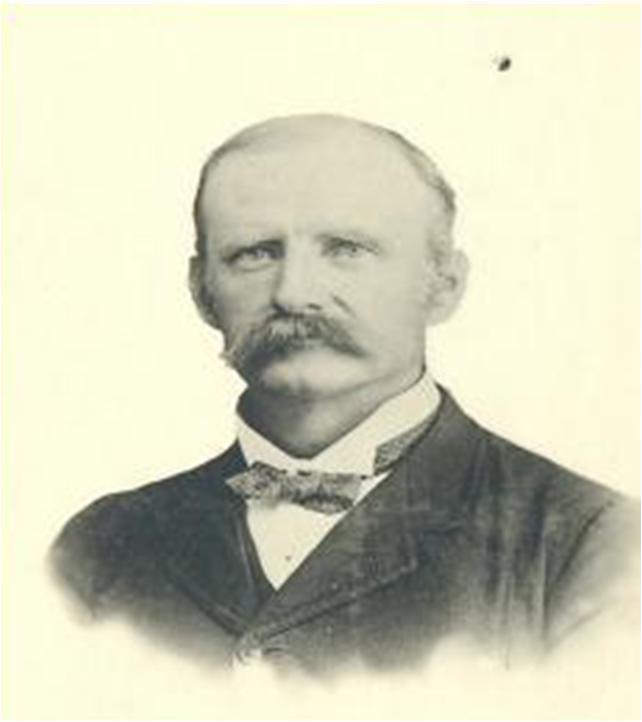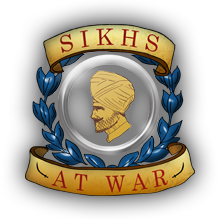Lt Col John Haughton, Commander 36th Sikhs
*** Watch Facebook Live: Haughton’s Memorial ***
It was an early start and long drive to Leicestershire earlier this month when we set out on a pilgrimage to immerse ourselves in the life of a man whose service to his country would earn him the description of ‘a hero of Tirah’.

Lt Col John Haughton, a hero of Tirah
Lt Col John Haughton was the commander of the 36th Sikhs on the Samana which in 1897 was the scene of a tribal uprising that would earn his regiment a battle honour. It would, of course, also be where the battle of Saragarhi took place and where 21 Sikhs would defend the small signalling post against the onslaught of 10,000 enemy tribesmen.
Haughton commanded his men from Fort Lockhart during the uprising, deploying the 21 to Saragarhi as well as reinforcing Fort Gulistan which was also under attack. His leadership was exceptional and was a testament to an officer who knew his men, had studied tactics and the local geography and knew how to counter the enemy.
Our trip to Leicestershire was with the aim of finding out and documenting more about Haughton’s character, about his Victorian education at Uppingham, a public school founded in 1584; and to see the memorial dedicated to his life and sacrifice.
It was a trip three years in the making, having discovered the connection during my research for my book I’d been in contact with the school but unable to make the trek for various reasons until now. It was well worth it, as you’ll see.
Haughton was born in August 1852 in India – where his father, Lt-Gen John Colpoys Haughton, was stationed. The General had served with the 31st Bengal infantry in the first Afghan war (1839-42) and distinguished himself during the defence of Charikar in 1841. A career-soldier and administrator, Haughton raised a family in India, his son John was born in August 1852 at Chota Nagpur.
There John Haughton would remain until August 1865, when at the age of 13 he was sent back to Britain to attend school. It was believed that public schools such as Uppingham ought to have an important part in the military training of the youth of the upper and middle classes.

Presenting Uppingham’s archivist Jerry Rudman with a copy of “Saragarhi: The Forgotten Battle”
Haughton, though while having a strong military figure in his father, did not distinguish himself during his schooling as evidenced in his reports. At 17 he went to a crammer to prepare for the entrance exam at Royal Military Academy Sandhurst, which he passed first time. He passed out in 1871 and was gazetted with the 1st Bn 24th Foot (later the South Wales Borderers). His father applied for John to be gazetted to a regiment in India, and he joined the 72nd Highlanders, which was stationed in Peshawar.
He later helped raise the 35th Sikhs in Ferozepur in May 1887 and remained with it before being brevetted as Lt Colonel to its sister-regiment the 36th, taking over command in June 1894. From April 1895 to December 1896 the regiment remained in Peshawar, before then marching onto the Samana to occupy the Forts and posts there.
Thereafter, Haughton led the 36th Sikhs during the Tirah Expedition, where it joined the 4th Brigade in protecting the right flank of the advancing troops on the Samana Suk. From the Dargai heights to the Maidan Valley, the 36th made the trek to subdue the Afridi and Orakzai tribes.
It was on 29th January 1898, five months after Saragarhi, that Haughton would fall while in battle. He was tasked to recce caves beyond the Shinkamar pass, but a misunderstanding in orders led to his party of Sikhs being exposed from the rear. The Pathans advanced and Haughton ordered his men to fix bayonets and fire the last of their ammunition. But the order to charge never came, a sniper hit Haughton with a bullet to the head, and he died.

With the documentary team at the memorial plaque for Haughton (Manpreet, Jay & Jayram)
Haughton would be buried at a British cemetery in Peshawar, and his brother officers in the 35th and 36th would raise a memorial plaque in his honour at the school chapel at Uppingham. The plaque would state: “Sacred to the memory of Lt. Col. John Haughton, Commandant of the 36th Sikhs who was killed in action at the Shinkamar pass N.W. Frontier of India 29th January 1898 while boldly defending a position to the last against overwhelming odds. This brass is erected by his brother officers of the 35th and 36th Sikhs.”
His biographer Major A.C Yates writes of Haughton’s qualities that he had a high sense of duty, strong religious feeling, staunchness, cool courage and a readiness to sacrifice himself. Much of the detail of his life and service can be found in “A Hero of Tirah” which I recommend for further reading.
Having known about his service and sacrifice, the trip to Uppingham gave us a deeper understanding of his education, and the values he gained from it. It was a rare treat to see such a prestigious place and to speak to an expert in the archivist Jerry Rudman, an interview of which we look forward to bringing to you in due course. And it was a remarkable opportunity to share Haughton’s story with the school, who knew little of what happened to their old boy after he left.
In the meantime, if you would like to see more, do check out the Facebook Live: Haughton’s Memorial which was broadcast during our trip.

Memorial Plaque to Lt Col John Haughton, copyright “Sikhs At War”.


